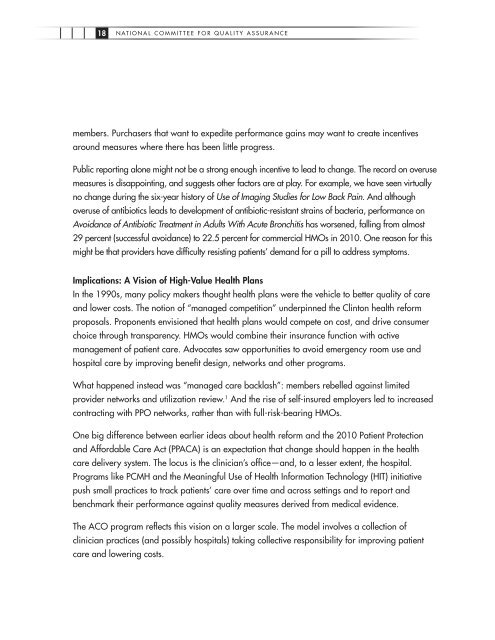Continuous Improvement and the Expansion of Quality ... - NCQA
Continuous Improvement and the Expansion of Quality ... - NCQA
Continuous Improvement and the Expansion of Quality ... - NCQA
You also want an ePaper? Increase the reach of your titles
YUMPU automatically turns print PDFs into web optimized ePapers that Google loves.
18<br />
N AT I o N A l C o M M I T T E E f o R Q U A l I T y A S S U R A N C E<br />
members. Purchasers that want to expedite performance gains may want to create incentives<br />
around measures where <strong>the</strong>re has been little progress.<br />
Public reporting alone might not be a strong enough incentive to lead to change. The record on overuse<br />
measures is disappointing, <strong>and</strong> suggests o<strong>the</strong>r factors are at play. for example, we have seen virtually<br />
no change during <strong>the</strong> six-year history <strong>of</strong> Use <strong>of</strong> Imaging Studies for Low Back Pain. And although<br />
overuse <strong>of</strong> antibiotics leads to development <strong>of</strong> antibiotic-resistant strains <strong>of</strong> bacteria, performance on<br />
Avoidance <strong>of</strong> Antibiotic Treatment in Adults With Acute Bronchitis has worsened, falling from almost<br />
29 percent (successful avoidance) to 22.5 percent for commercial HMos in 2010. one reason for this<br />
might be that providers have difficulty resisting patients’ dem<strong>and</strong> for a pill to address symptoms.<br />
Implications: a vision <strong>of</strong> High-value Health Plans<br />
In <strong>the</strong> 1990s, many policy makers thought health plans were <strong>the</strong> vehicle to better quality <strong>of</strong> care<br />
<strong>and</strong> lower costs. The notion <strong>of</strong> “managed competition” underpinned <strong>the</strong> Clinton health reform<br />
proposals. Proponents envisioned that health plans would compete on cost, <strong>and</strong> drive consumer<br />
choice through transparency. HMos would combine <strong>the</strong>ir insurance function with active<br />
management <strong>of</strong> patient care. Advocates saw opportunities to avoid emergency room use <strong>and</strong><br />
hospital care by improving benefit design, networks <strong>and</strong> o<strong>the</strong>r programs.<br />
What happened instead was “managed care backlash”: members rebelled against limited<br />
provider networks <strong>and</strong> utilization review. 1 And <strong>the</strong> rise <strong>of</strong> self-insured employers led to increased<br />
contracting with PPo networks, ra<strong>the</strong>r than with full-risk-bearing HMos.<br />
one big difference between earlier ideas about health reform <strong>and</strong> <strong>the</strong> 2010 Patient Protection<br />
<strong>and</strong> Affordable Care Act (PPACA) is an expectation that change should happen in <strong>the</strong> health<br />
care delivery system. The locus is <strong>the</strong> clinician’s <strong>of</strong>fice—<strong>and</strong>, to a lesser extent, <strong>the</strong> hospital.<br />
Programs like PCMH <strong>and</strong> <strong>the</strong> Meaningful Use <strong>of</strong> Health Information Technology (HIT) initiative<br />
push small practices to track patients’ care over time <strong>and</strong> across settings <strong>and</strong> to report <strong>and</strong><br />
benchmark <strong>the</strong>ir performance against quality measures derived from medical evidence.<br />
The ACo program reflects this vision on a larger scale. The model involves a collection <strong>of</strong><br />
clinician practices (<strong>and</strong> possibly hospitals) taking collective responsibility for improving patient<br />
care <strong>and</strong> lowering costs.


